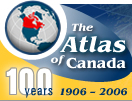| The financial services include activities that
operate like convenience retail (banks and credit unions) and those
that operate like retail shopping activity (stockbrokers and insurance
companies). Financial services, in general, are strongly oriented
to big cities and to high-income locations.
 [D] [D]
Click for more information, 25 KB
Photograph of a bank, Ottawa, Ontario
Geographical Description
On this map, the size of the circles is proportional to the population
of the cities, while the degree of specialization for financial
services is shown by the colour in the legend. Smaller centres in
the Prairie provinces appear to be specialized in financial services
because of their extensive market areas. Two examples of these smaller
centres are Swift Current, Saskatchewan and Lloydminster, which
straddles the Alberta and Saskatchewan border. Similarly, clusters
of cities surrounding the Toronto and Montréal metropolitan
areas attract financial activities that serve the metropolitan region.
Financial services appear to avoid peripheral locations in the north
and small manufacturing cities in Ontario and Quebec. Rural and
urban differences in financial-activity specialization are very
strong, This is especially noticeable in northern Ontario, which
has low specialization compared to southern Ontario, where there
is higher specialization in financial services due to the higher
population of southern Ontario and its proximity to larger urban
centres in the United States.
To properly interpret this map, please consult the text Data
and Mapping Notes.
|
